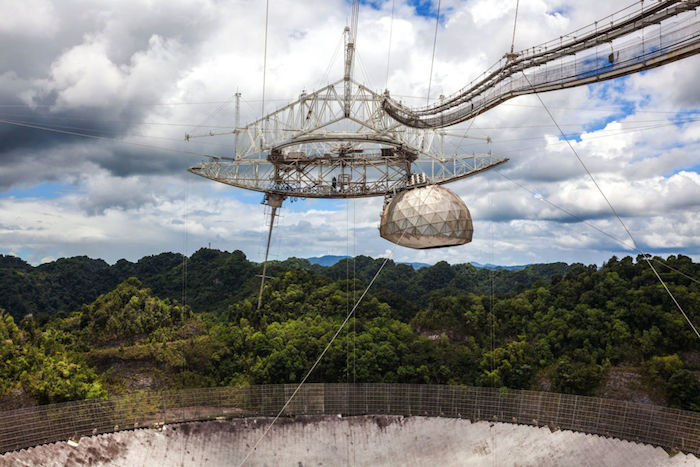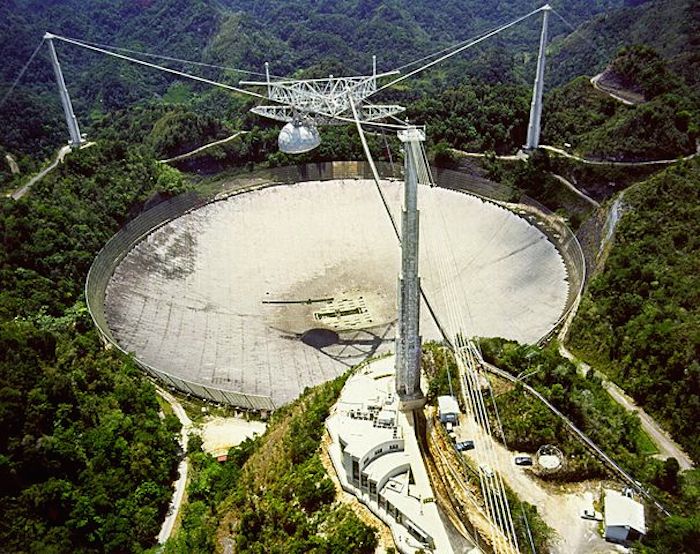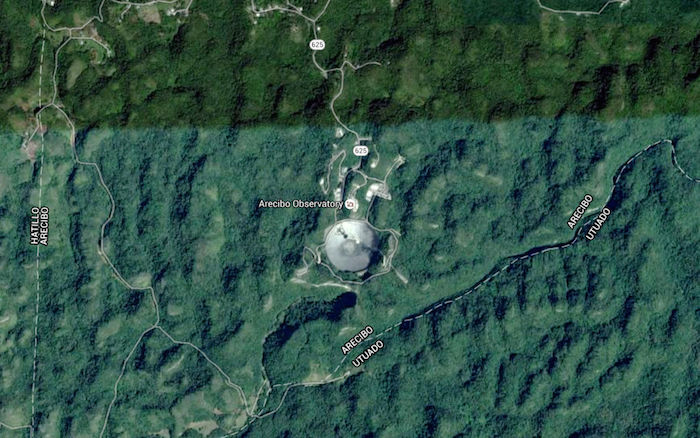.

Worlds largest single-dish radio telescope, the Arecibo Observatory, Arecibo, Puerto Rico. (Photo by: Universal Images Group via Getty Images) PHOTOGRAPH BY UNIVERSAL IMAGES GROUP VIA GETTY IMAGES
(Hear Nadia Drake interviewed live about the Arecibo telescope on Science Friday from Public Radio International, on Friday June 10 at 2 p.m. EST/11 a.m. PST.)
SAN JUAN and ARECIBO, Puerto Rico — Francisco Cordova just started his job as director of Puerto Rico’s Arecibo Observatory, the world’s largest radio telescope. But at a public meeting on day two of his new post, he was already facing the iconic telescope’s potential demolition.
At meetings June 7 in San Juan and Arecibo, students, scientists, observatory staff and community members spoke about what would be lost in terms of science and education if the observatory were to close, an outcome that no one in attendance seemed to find acceptable in any way. As the world’s largest single-dish radio telescope, Arecibo is famous for searching for distant galaxies, gravitational waves, and signs of extraterrestrial life.
The meetings gave the community a chance to speak directly to representatives from the National Science Foundation, the U.S. science agency responsible for deciding Arecibo’s fate, and which is now facing tough choices thanks to flatlined budgets.
“It’s a concern, but I know we will find a way,” Cordova says.
.

The Arecibo Observatory, easily recognizable from feature films and a symbol of the search for extraterrestrial life, may not be around much longer due to funding.
-
Cordova, like many Puerto Ricans, visited Arecibo when he was a kid. Back then, he was struck by the facility itself, with its 900-ton platform looming above a dish stretching 1,000 feet across. “To be able to come here and help out and help lead what’s going to be the future—it’s exciting because it gives me the opportunity to make a difference,” Cordova says.
The meetings were not particularly well attended, and notably absent were many local government officials, including the Arecibo mayor—observations that prompted some to question how well NSF had publicized the meetings.
At the start of the meetings, NSF officers quickly reminded everyone that no decisions about Arecibo’s future had been made.
“We’re not here today to announce the closing of Arecibo, or the reduction of any funding whatsoever,” said Ralph Gaume, Arecibo program officer within the agency’s Astronomical Sciences Division. But, a dismal federal funding climate means NSF needs to cut funding “for a number of its astronomical and geospace science facilities,” he said.
Unfortunately, it looks like those facilities include Arecibo. A number of recent review panels, charged with evaluating and prioritizing various NSF observatories, have recommended significantly reducing funding for the observatory. Currently, NSF provides $8.2 million annually for Arecibo, and $3.7 million comes from NASA, which funds the study of potentially Earth-destroying asteroids.
So, losing the bulk of NSF money would effectively shut down the observatory.
That’s why two weeks ago, the agency released a notice of intent to investigate the environmental impacts of potential Arecibo futures—a process required before any federal facility can be decommissioned. The notice identified five possibilities, ranging from continuing current operations, which now looks unlikely, to dismantling the telescope and returning the site to its natural state. Other options involve finding funding partners or mothballing the telescope so that it could be resurrected if funding reappears.
Losses for Science
One could argue that this all makes a fair bit of sense, given squeezed resources and reports dating back to 2006 that recommend prioritizing Arecibo below other observatories, such as the Atacama Large Millimeter/submillimeter Array.
Trouble is, scientists argued at the meetings, those reports are mostly old, outdated, and don’t take into account the current scientific landscape.
“A very important thing to remember is that the scientific context for those reports has changed,” said Scott Ransom of the National Radio Astronomy Observatory. Ransom pointed to the recent announcement that gravitational waves had been directly detected—a huge discovery. Arecibo plays a crucial role in detecting gravitational waves, said Xavier Siemens, chair of NANOGrav, the experiment using the telescope to search for those waves.
“We are now at a time when we have reached unprecedented sensitivities and expect to make a detection soon,” Siemens said. “Arecibo is the most sensitive radio telescope in the world, and a lack of access to this instrument would cripple our observatory.”
.

The Arecibo Observatory, as seen on Google Earth.
Qihou Zhou, from Miami University, also argued that the observatory’s work in the atmospheric sciences is crucial to understanding long-term changes in Earth’s climate. While surface temperatures can exhibit significant local variations, reliable indications of a warming climate hide in the upper atmosphere.
“As the surface temperature rises, the upper atmosphere cools,” Zhou said, noting that Arecibo’s data set spans 50 years, an almost unheard-of amount of time. “Clearly, the longer the data set is available, the easier it is to discern any long-term change. Continuous operation of Arecibo is important to understand climate change and our space environment.”
And then there’s that whole issue of killer asteroids and comets. Arecibo’s radar capabilities are vastly superior to any other facility on Earth, and allow scientists to efficiently characterize potentially destructive impactors. That’s important for lessening environmental impacts to planet Earth as a whole, Arecibo’s planetary radar lead Patrick Taylor said.
NASA says it will continue to fund this work at Arecibo as long as NSF operates the telescope.
“If it is closed, NASA will continue to have planetary radar capability with its own Goldstone facility, a part of its Deep Space Network,” wrote Lindley Johnson, NASA’s Planetary Defense Officer, in an email. “However, the Goldstone Solar System Radar is not as powerful as Arecibo’s, so it will not have quite the same range into space as Arecibo.”
Educational Casualties
Science isn’t the only concern at Arecibo. In fact, the majority of people at the meetings discussed the role the observatory plays in inspiring and training Puerto Rican students, some 20,000 of whom visit the site every year.
Though it’s hard to quantify, the value of inspiration and education is not insignificant, especially considering how underrepresented Hispanic students are in the sciences.
As evidence, several students involved in the Arecibo Observatory Space Academy spoke about how important their time at the observatory was, and how this pre-college program gave them hands-on research experience that continues to affect their lives.
“I can say that AOSA has had a great impact on my life,” said Adriana Lopez, a 14-year-old space academy alum. “Always, in my life, I’ve been fascinated with space, and it has led me to join several camps, but none of them have affected me like AOSA. This academy provided me with skills not even my own academic institution did.“
Luisa Zambrano, a graduate student who’s not only using Arecibo data in her dissertation but is involved in running the space academy, said that 100 percent of academy students that have graduated from high school are now in college. Further, she said, among the more than 150 students that have come through the program, “we’ve been able to maintain almost even male:female ratios—which is very unusual for science. Especially among Hispanics.”
That’s not all.
“Over the last five years, we have had 24 Hispanic students or teachers,” said Robert Minchin, Arecibo’s radioastronomy lead and summer internship supervisor. That might not sound like a lot, he said, but it’s more than the typical graduating class at a U.S university.
“It’s not possible to give someone a research experience if you’re not doing research,” Minchin said.
If You Build It, They Will Come
In addition to its important role in science and education, Arecibo is also a prized local resource, community members argued. And it doesn’t make sense to assume its cultural value can be maintained if science shuts down.
“Tourists wouldn’t come to the site to see a hole in the ground where the telescope used to be. Students wouldn’t be inspired by a telescope that is not there anymore,” said Joan Schmelz, deputy director of the observatory. “The science inspires the kids that come to the observatory and the tourists who come to visit.”
That Arecibo plays a role in bringing tourists to the area is undeniable: As many as 100,000 visit each year. It also brings scientists and their families, and provides jobs for the local community.
It may also help preserve the local landscape. That somewhat surprising comment came from Miguel Sarriera, an attorney from the town of Quebradillas, on the island’s northern coast. Restrictions on AM, FM, and TV transmissions within a four-mile radius of the telescope, he said, have effectively prevented development and indirectly protected the naturally beautiful forests carpeting the regions karst terrain.
“If there is no observatory, these prohibitions are irrelevant,” he said. “The indirect environmental benefits that they currently represent will be no longer available.”
The Next Steps
Though no decision has been yet, there are many roadblacks on the route to completely dismantling the telescope.
Among those is Arecibo’s listing on the National Register of Historic Places, which was approved late last year after former observatory director Robert Kerr pushed to have it included. And as one might expect, destroying a nationally significant historic site isn’t simply a matter of coming in with a big enough bulldozer. Various legislation requires that NSF assess and resolve any adverse effects its actions might cause, and take care “to minimize harm to any National Historic Landmark that may be directly and adversely affected by an undertaking.”
The agency hopes to wrap up this process by next summer. Caroline Blanco, NSF’s assistant general counsel, says the agency intends to publish a draft environmental impact statement as early as this fall. That will be followed by another public comment period, and the final report will be published in the spring of 2017. After another comment period, the agency will make its final decision.
“We anticipate that decision will be issued at some point in the summer of 2017,” Blanco said. “Ambiguity in the target dates is largely due to the fact that this is a public process and we cannot at this juncture anticipate what the public comments will be and how we will respond to them.”
That may not sound particularly fast, but it’s the equivalent of an eyeblink when you consider the pace at which federal agencies normally rumble along.
“The timeline is aggressive,” Cordova says. But that’s not necessarily bad. One of the frustrations Cordova is already experiencing comes with not knowing when or if the observatory will close: It’s impossible to plan and invest in upgrades, for example, when the telescope’s expiration date is a mystery.
“This has been going on for how long now?” Cordova asks. “We need to have an honest conversation and say, this is the long-term plan, this is going to be the long-term strategy, this is the long-term commitment from NSF – if it’s $1 million, if it’s half a million, whatever they’re going to say — let’s work together so that we can put a realistic plan together. Let’s not kid ourselves.”
Quelle: NationalGeographic
4653 Views
